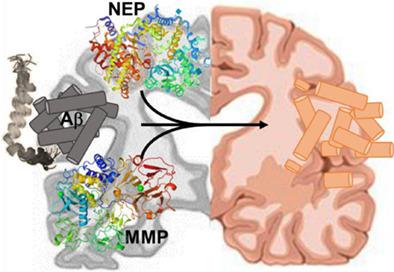当前位置:
X-MOL 学术
›
Bull. Korean Chem. Soc.
›
论文详情
Our official English website, www.x-mol.net, welcomes your
feedback! (Note: you will need to create a separate account there.)
Potent therapeutic targets for treatment of Alzheimer's disease: Amyloid degrading enzymes
Bulletin of the Korean Chemical Society ( IF 2.3 ) Pub Date : 2021-09-15 , DOI: 10.1002/bkcs.12390 Hang Choi 1 , Eungchan Kim 1 , Jae Yoon Choi 1 , Eunsik Park 2 , Hyuck Jin Lee 1
Bulletin of the Korean Chemical Society ( IF 2.3 ) Pub Date : 2021-09-15 , DOI: 10.1002/bkcs.12390 Hang Choi 1 , Eungchan Kim 1 , Jae Yoon Choi 1 , Eunsik Park 2 , Hyuck Jin Lee 1
Affiliation

|
In an aging society in the world, dementia that leads to pain in patients and their families has become a common disease in our lives. Among dementia, Alzheimer's disease (AD) is the most commonly shown disease. Various causes of the disease have been proposed and amyloid hypothesis insists that the toxic amyloid-β (Aβ) species could be the major risk factor of the onset and progression of AD. In this perspective, clearance of Aβ species from the brain by regulating the activity of amyloid degrading enzymes (ADE), including neprilysin and matrix metalloproteinases, could be a potent treatment for AD. Therefore, the structures and functions of these enzymes along with biological molecules in the brain would be important to understand the pathogenesis of AD and develop an effective medication for the disease. In this review, multiple ADE with biological molecules which could affect the activities and/or expression of the enzymes are summarized.
中文翻译:

治疗阿尔茨海默病的有效治疗靶点:淀粉样蛋白降解酶
在世界老龄化社会中,给患者及其家人带来痛苦的痴呆症已成为我们生活中的常见病。在痴呆症中,阿尔茨海默病 (AD) 是最常见的疾病。已经提出了该疾病的各种原因,淀粉样蛋白假说坚持认为有毒的淀粉样蛋白-β (Aβ) 物种可能是 AD 发生和发展的主要危险因素。从这个角度来看,通过调节淀粉样蛋白降解酶 (ADE) 的活性,包括脑啡肽酶和基质金属蛋白酶,从大脑中清除 Aβ 物质可能是治疗 AD 的有效方法。因此,这些酶的结构和功能以及大脑中的生物分子对于了解 AD 的发病机制和开发针对该疾病的有效药物非常重要。在这次审查中,
更新日期:2021-11-22
中文翻译:

治疗阿尔茨海默病的有效治疗靶点:淀粉样蛋白降解酶
在世界老龄化社会中,给患者及其家人带来痛苦的痴呆症已成为我们生活中的常见病。在痴呆症中,阿尔茨海默病 (AD) 是最常见的疾病。已经提出了该疾病的各种原因,淀粉样蛋白假说坚持认为有毒的淀粉样蛋白-β (Aβ) 物种可能是 AD 发生和发展的主要危险因素。从这个角度来看,通过调节淀粉样蛋白降解酶 (ADE) 的活性,包括脑啡肽酶和基质金属蛋白酶,从大脑中清除 Aβ 物质可能是治疗 AD 的有效方法。因此,这些酶的结构和功能以及大脑中的生物分子对于了解 AD 的发病机制和开发针对该疾病的有效药物非常重要。在这次审查中,











































 京公网安备 11010802027423号
京公网安备 11010802027423号